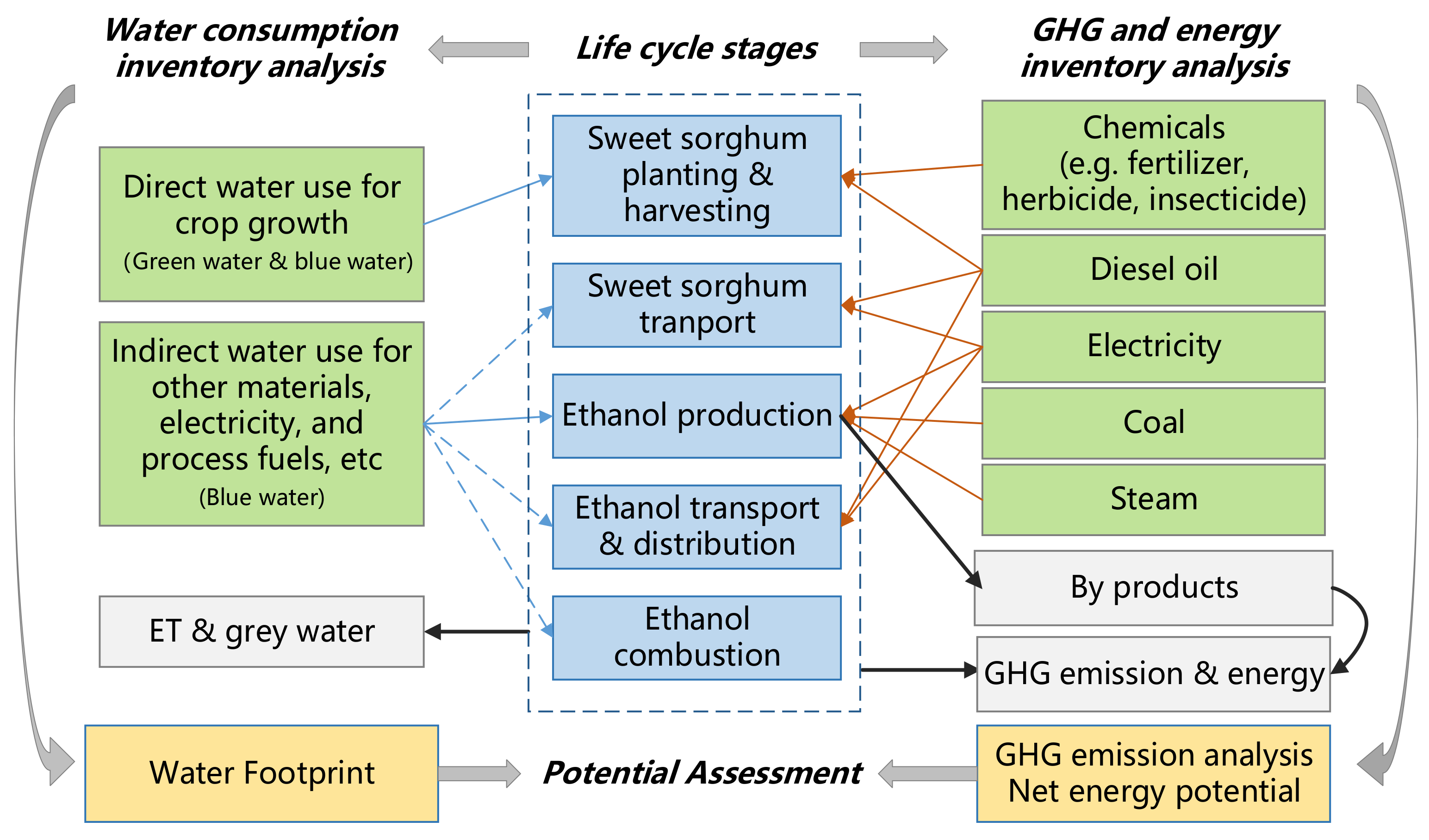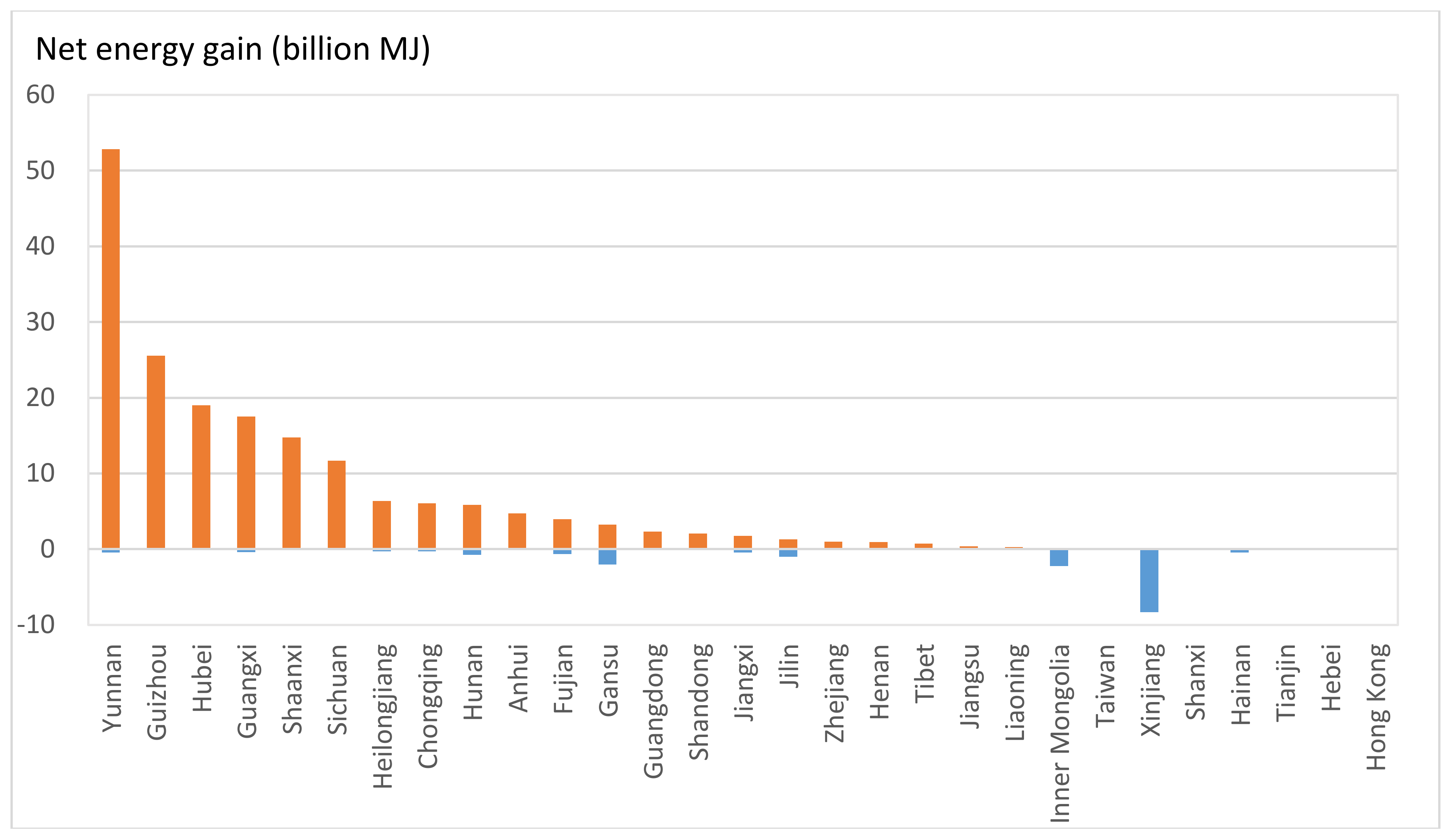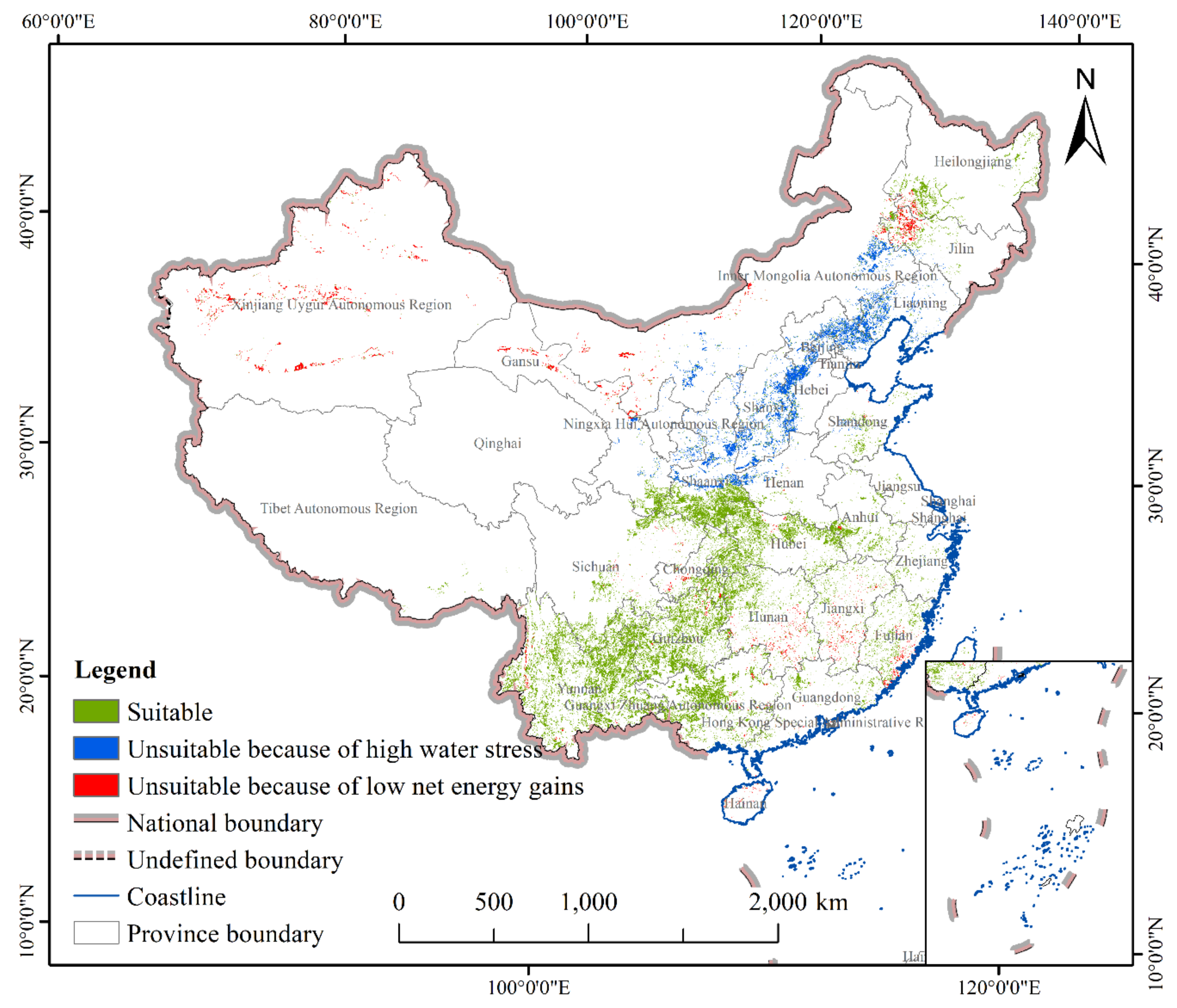Assessment of Sweet Sorghum-Based Ethanol Potential in China within the Water–Energy–Food Nexus Framework
Abstract
:1. Introduction
2. Materials and Methods
2.1. System Boundary Definition
2.2. Biomass and ET (Evapotranspiration) Estimation by the DSSAT Model
2.3. Life Cycle Assessment
2.3.1. Water Consumption Assessment
2.3.2. Life Cycle Assessment of Net Energy Gain (NEG) Potential
2.3.3. Life Cycle Assessment of GHG Emission
2.4. Data Preparation
2.4.1. Geospatial Datasets
2.4.2. Non-Geospatial Datasets
3. Results
3.1. Biomass and ET Estimation Results
3.2. Water Consumption Assessment Result
3.3. Net Energy Gain Assessment Result
3.4. Marginal Lands Suitable for Sweet Sorghum-Based Ethanol Development
3.5. GHG Emission Assessment Result
4. Discussion
4.1. Comparison with Other Studies
4.2. Measures for Improving Potential Assessment
5. Conclusions
Acknowledgments
Author Contributions
Conflicts of Interest
References
- Streck, C.; Unger, M.V.; Keenlyside, P. The Paris agreement: A new beginning. J. Eur. Environ. Plan. Law 2016, 13, 3–29. [Google Scholar] [CrossRef]
- United Nations Framework Convention on Climate Change. Paris Agreement; United Nations Framework Convention on Climate Change: Paris, France, 2015. [Google Scholar]
- Teske, S.; Lins, C.; Hullin, M.; Williamson, L.; Fattal, A. Renewables Global Futures Report: Great Debates towards 100% Renewable Energy; REN21: Paris, France, 2017. [Google Scholar]
- Srirangan, K.; Akawi, L.; Moo-Young, M.; Chou, C.P. Towards sustainable production of clean energy carriers from biomass resources. Appl. Energy 2012, 100, 172–186. [Google Scholar] [CrossRef]
- Muth, D.J., Jr.; Bryden, K.M.; Nelson, R.G. Sustainable agricultural residue removal for bioenergy: A spatially comprehensive US national assessment. Appl. Energy 2013, 102, 403–417. [Google Scholar] [CrossRef]
- BP. BP Energy Outlook, 2018 ed. Available online: https://www.bp.com/en/global/corporate/energy-economics/energy-outlook.html (assessed on 1 March 2018).
- Zhang, X.D.; Vesselinov, V.V. Integrated modeling approach for optimal management of water, energy and food security nexus. Adv. Water Resour. 2017, 101, 1–10. [Google Scholar] [CrossRef]
- Vogt, K.; Patel-Weynand, T.; Shelton, M.; Vogt, D.J.; Gordon, J.C.; Mukumoto, C.; Suntana, A.S.; Roads, P.A. Sustainability Unpacked: Food, Energy and Water for Resilient Environments and Societies; Routledge: Gateshead, UK, 2012. [Google Scholar]
- United Nations Economic and Social Commission for Asia (UNESCAP). The Status of the Water-Food-Energy Nexus in Asia and the Pacific; UNESCAP: Bangkok, Thailand, 2013. [Google Scholar]
- Chang, Y.; Li, G.J.; Yao, Y.; Zhang, L.X.; Yu, C. Quantifying the water-energy-food nexus: Current status and trends. Energies 2016, 9. [Google Scholar] [CrossRef]
- Andrewsspeed, P.; Bleischwitz, R.; Boersma, T.; Johnson, C.; Kemp, G.; Vandeveer, S.D. The Global Resource Nexus: The Struggles for Land, Energy, Food, Water, and Minerals; Transatlantic Academy: Washington, DC, USA, 2012. [Google Scholar]
- Hoff, H. Understanding the Nexus. Background Paper for the Bonn2011 Conference: The Water, Energy and Food Security Nexus; SEI: Stockholm, Sweden, 2011. [Google Scholar]
- Food and Agriculture Organization (FAO). The Water-Energy-Food Nexus: A New Approach in Support of Food Security and Sustainable Agriculture; FAO: Rome, Italy, 2014. [Google Scholar]
- Seachinger, T.; Ralph, H. Avoiding Bioenergy Competition for Food Crops and Land; World Resources Institute: Washington, DC, USA, 2015. [Google Scholar]
- Yimam, Y.T.; Ochsner, T.E.; Fox, G.A. Hydrologic cost-effectiveness ratio favors switchgrass production on marginal croplands over existing grasslands. PLoS ONE 2017, 12, e0181924. [Google Scholar] [CrossRef] [PubMed]
- Hao, M.M.; Jiang, D.; Wang, J.H.; Fu, J.Y.; Huang, Y.H. Could biofuel development stress China’s water resources? Gcb Bioenergy 2017, 9, 1447–1460. [Google Scholar] [CrossRef]
- Xie, X.; Zhang, T.; Wang, L.; Huang, Z. Regional water footprints of potential biofuel production in china. Biotechnol. Biofuels 2017, 10, 95. [Google Scholar] [CrossRef] [PubMed]
- Flammini, A.; Puri, M.; Pluschke, L.; Dubois, O. Walking the nexus talk: Assessing the water-energy-food nexus in the context of the sustainable energy for all initiative. J. Phys. Chem. A 2014, 115, 7869–7870. [Google Scholar]
- Gosens, J.; Kåberger, T.; Wang, Y. China’s next renewable energy revolution: Goals and mechanisms in the 13th five year plan for energy. Energy Sci. Eng. 2017, 5, 141–155. [Google Scholar] [CrossRef]
- Li, S.; Li, G.; Zhang, L.; Zhou, Z.; Han, B.; Hou, W.; Wang, J.; Li, T. A demonstration study of ethanol production from sweet sorghum stems with advanced solid state fermentation technology. Appl. Energy 2013, 102, 260–265. [Google Scholar] [CrossRef]
- Almodares, A.; Hadi, M.R.; Kholdebarin, B.; Samedani, B.; Kharazian, Z.A. The response of sweet sorghum cultivars to salt stress and accumulation of Na+, Cl− and K+ ions in relation to salinity. J. Environ. Biol. 2014, 35, 733–739. [Google Scholar] [PubMed]
- Zegada-Lizarazu, W.; Luna, D.F.; Monti, A. Differential characteristics of photochemical acclimation to cold in two contrasting sweet sorghum hybrids. Physiol. Plant. 2016, 157, 479–489. [Google Scholar] [CrossRef] [PubMed]
- Reap, J.; Roman, F.; Duncan, S.; Bras, B. A survey of unresolved problems in life cycle assessment. Int. J. Life Cycle Assess. 2008, 13, 290–300. [Google Scholar] [CrossRef]
- Houshyar, E.; Grundmann, P. Environmental impacts of energy use in wheat tillage systems: A comparative life cycle assessment (LCA) study in Iran. Energy 2017, 122, 11–24. [Google Scholar] [CrossRef]
- International Organization for Standardization (ISO). Environmental Management-Life Cycle Assessment-Requirements and Guidelines; ISO: Geneva, Switzerland, 2006; Volume 14044. [Google Scholar]
- Jones, J.W.; Hoogenboom, G.; Porter, C.H.; Boote, K.J.; Batchelor, W.D.; Hunt, L.A.; Wilkens, P.W.; Singh, U.; Gijsman, A.J.; Ritchie, J.T. The DSSAT cropping system model. Eur. J. Agron. 2003, 18, 235–265. [Google Scholar] [CrossRef]
- Wang, M.; Han, J.W.; Dunn, J.B.; Cai, H.; Elgowainy, A. Well-to-wheels energy use and greenhouse gas emissions of ethanol from corn, sugarcane and cellulosic biomass for US use. Environ. Res. Lett. 2012, 7, 045905. [Google Scholar] [CrossRef]
- Wu, M.; Wang, M.; Hong, H. Fuel-Cycle Assessment of Selected Bioethanol Production; Argonne National Laboratory: Lemont, IL, USA, 2007.
- Burnham, A.; Wang, M.Q.; Wu, Y. Development and Applications of GREET 2.7—The Transportation Vehicle-CycleModel; Argonne National Laboratory: Lemont, IL, USA, 2006.
- Ritchie, J.T. Model for predicting evaporation from a row crop with incomplete cover. Water Resour. Res. 1972, 8, 1204–1213. [Google Scholar] [CrossRef]
- Fu, J. Assessment of the Non-Grain Based Fuel Ethanol Potential in China; The University of Chinese Academy of Sciences: Beijing, China, 2015. [Google Scholar]
- Hao, M. Evaluation of Energy Saving Potential and GHG Reductionpotential of Bio-Fuel Ethanol from Cassava at Large Scale; The University of Chinese Academy of Sciences: Beijing, China, 2015. [Google Scholar]
- Liu, L.; Zhuang, D.F.; Jiang, D.; Fu, J.Y. Assessment of the biomass energy potentials and environmental benefits of Jatropha curcas L. in Southwest China. Biomass Bioenergy 2013, 56, 342–350. [Google Scholar] [CrossRef]
- Zhang, F.L.; Johnson, D.M.; Wang, J.J. Life-cycle energy and GHG emissions of forest biomass harvest and transport for biofuel production in Michigan. Energies 2015, 8, 3258–3271. [Google Scholar] [CrossRef]
- Fu, J.; Dong, J.; Huang, Y.; Zhuang, D.; Wei, J. Evaluating the marginal land resources suitable for developing bioenergy in Asia. Adv. Meteorol. 2014, 2014, 45–49. [Google Scholar] [CrossRef]
- Jiang, D.; Hao, M.; Fu, J.; Zhuang, D.; Huang, Y. Spatial-temporal variation of marginal land suitable for energy plants from 1990 to 2010 in China. Sci. Rep. 2014, 4, 5816. [Google Scholar] [CrossRef] [PubMed]
- Hoogenboom, G.; Porter, C.H.; Shelia, V.; Boote, K.J.; Singh, U.; White, J.W.; Hunt, L.A.; Ogoshi, R.; Lizaso, J.I.; Koo, J.; et al. Decision Support System for Agrotechnology Transfer (DSSAT) Version 4.7. Available online: https://DSSAT.net (accessed on 2 November 2017).
- Hutchinson, M.F.; Xu, T. Anusplin Version 4.2 User Guide; Centre for Resource and Environmental Studies, The Australian National University: Canberra, Australia, 2004. [Google Scholar]
- Wang, M.; Chen, Y.; Xia, X.; Li, J.; Liu, J. Energy efficiency and environmental performance of bioethanol production from sweet sorghum stem based on life cycle analysis. Bioresour. Technol. 2014, 163, 74–81. [Google Scholar] [CrossRef] [PubMed]
- Olukoya, I.A.; Bellmer, D.; Whiteley, J.R.; Aichele, C.P. Evaluation of the environmental impacts of ethanol production from sweet sorghum. Energy Sustain. Dev. 2015, 24, 1–8. [Google Scholar] [CrossRef]









| Dataset | Unit | Spatial Resolution | Data Source |
|---|---|---|---|
| Marginal land | - | 1 km × 1 km | Derived from LUCC, weather data, soil data, and DEM |
| DEM | m | 90 m × 90 m | NASA Shuttle Radar Topographic Mission (SRTM) 1 |
| Daily maximum air temperature | Degrees Celsius | 10 km × 10 km | Derived from station observation daily maximum air temperature provided by the China Meteorological Administration 2 using ANUSPLIN Vrsn 4.3 [38] |
| Daily minimum air temperature | Degrees Celsius | 10 km × 10 km | Derived from station observation daily minimum air temperature provided by the China Meteorological Administration 2 using ANUSPLIN Vrsn 4.3 [38] |
| Precipitation | mm | 10 km × 10 km | Derived from station observation precipitation provided by the China Meteorological Administration 2 using ANUSPLIN Vrsn 4.3 [38] |
| Solar radiation | moles·m−2·day−1 | 10 km × 10 km | Derived from station observation solar radiation data provided by the China Meteorological Administration 2 using ANUSPLIN Vrsn 4.3 [38] |
| Mean annual temperature | Degrees Celsius | 10 km × 10 km | Derived from daily mean air temperature provided by the China Meteorological Administration 2 |
| Annual air temperature amplitude | Degrees Celsius | 10 km × 10 km | Derived from daily maximum and minimum air temperature provided by the China Meteorological Administration 2 |
| Soil profiles | - | 1 km × 1 km | The published GSDE (Global Soil Data Set for Earth System Modeling) database named |
| Dataset | Data Source |
|---|---|
| Field experiment data | Field experiment records |
| Crop cultivar coefficients | Calibrated using the GLUE (Generalized Likelihood Uncertainty Estimation) method based on field experiment data |
| Field management data | Literature and field experiment records |
| Water consumption at ethanol production stage | Literature, investigation and survey records |
| Gross water of every basin | Literature, statistical data |
| Life cycle inventories of GHG emission | Literature, investigation and survey records |
| Life cycle inventories of net energy gain | Literature, investigation and survey records |
| Data Item | Data | Unit |
|---|---|---|
| Conversion coefficient (from sweet sorghum to fuel ethanol) | 16 [16] | - |
| Water density | 1.0 [16] | g·cm−3 |
| Water consumption coefficient | 9.5 [16] | t water·t−1 ethanol |
| Stage | Energy 1 | GHG Emissions | Items |
|---|---|---|---|
| Sweet sorghum planting stage | −15362.48 MJ/ha [31] | +145.58 kg C/ha [32] | Nitrogen fertilizer, phosphate fertilizer, potassium fertilizer, herbicide, insecticide, diesel oil |
| Sweet sorghum transport stage | −3106.75 MJ/t ethanol [31] | +59.84 kg C/t ethanol [32] | Diesel oil and electricity |
| Ethanol production | −36433.75 MJ/t ethanol [31] | +522.73 kg C/t ethanol [32] | Electricity, coal, and steam |
| By-products | +17310.60 MJ/t [31] | −106 kg C/t ethanol [32] | |
| Ethanol transport | −262.35 MJ/t ethanol [31] | +5.68 kg C/t ethanol [32] | Diesel oil and electricity |
| Ethanol combustion | +29660 MJ/t ethanol [31] | -- | Energy and GHG produced directly by ethanol combustion |
© 2018 by the authors. Licensee MDPI, Basel, Switzerland. This article is an open access article distributed under the terms and conditions of the Creative Commons Attribution (CC BY) license (http://creativecommons.org/licenses/by/4.0/).
Share and Cite
Yan, X.; Jiang, D.; Fu, J.; Hao, M. Assessment of Sweet Sorghum-Based Ethanol Potential in China within the Water–Energy–Food Nexus Framework. Sustainability 2018, 10, 1046. https://doi.org/10.3390/su10041046
Yan X, Jiang D, Fu J, Hao M. Assessment of Sweet Sorghum-Based Ethanol Potential in China within the Water–Energy–Food Nexus Framework. Sustainability. 2018; 10(4):1046. https://doi.org/10.3390/su10041046
Chicago/Turabian StyleYan, Xiaoxi, Dong Jiang, Jingying Fu, and Mengmeng Hao. 2018. "Assessment of Sweet Sorghum-Based Ethanol Potential in China within the Water–Energy–Food Nexus Framework" Sustainability 10, no. 4: 1046. https://doi.org/10.3390/su10041046
APA StyleYan, X., Jiang, D., Fu, J., & Hao, M. (2018). Assessment of Sweet Sorghum-Based Ethanol Potential in China within the Water–Energy–Food Nexus Framework. Sustainability, 10(4), 1046. https://doi.org/10.3390/su10041046







